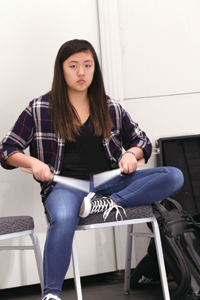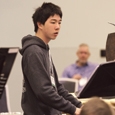 As a director, it took me many years to figure out the musical needs of student percussionists. All too often, percussionists get labeled as lazy or unfocused, whether the reputation is earned or not. I can think of many band jokes that revolve around the shenanigans of percussionists. I eventually concluded that I needed to understand my percussionists better. I share the following advice with the hope of increasing your awareness of how to support and challenge your percussionists.
As a director, it took me many years to figure out the musical needs of student percussionists. All too often, percussionists get labeled as lazy or unfocused, whether the reputation is earned or not. I can think of many band jokes that revolve around the shenanigans of percussionists. I eventually concluded that I needed to understand my percussionists better. I share the following advice with the hope of increasing your awareness of how to support and challenge your percussionists.
In nearly every moment of a given piece, a percussionist is essentially a soloist. Directors often take for granted that wind players can rely upon other players around them to provide confidence and context. With few exceptions, wind sections enter at the same time and often in tandem with other sections. Directors frequently cue these entrances because there are so many players entering at the same time.
A percussionist, on the other hand, typically has more rests between entrances and is the only person playing a particular instrument at a given moment. This can prove exhilarating and scary at the same time. If you have the benefit of teaching with a colleague, play one of the percussion parts in rehearsal the next time that a student is absent. The level of accountability can be quite intense. Be sure to cue important percussion entrances, not just wind entrances. More importantly, help your percussionists relate their part to other parts that they hear, such as melodies or obvious changes in texture.
Select literature with the musical skills of your percussionists in mind. This often gets overlooked when considering music to perform. Our instincts are drawn to the technical demands of the wind parts. (Do I have a student who can play that oboe solo?) Give the percussion parts the same thoughtful consideration and assign them to specific players when possible. It is a mistake to allow students to distribute the parts themselves. More assertive students will often pick what they perceive as the best parts, resulting in animosity between players. This can also result in players selecting parts that they cannot play well, which can frustrate the director and band. Additionally, players may end up playing the same instrument multiple times rather than expanding their knowledge of all percussion instruments.
Program music that involves as many of percussionists as possible. I rarely program music during which any of the percussionists are idle. This can be difficult in reality, but make it your goal. Adjust your programming based on the size of the percussion section in each ensemble from year to year. I will often create additional mallet parts when possible from a flute or oboe part to augment the number of percussion parts, particularly in ballads. If your program sends percussionists out of full rehearsals for sectionals, then plan on rehearsing broad sections of music that do not use percussion on their sectional days. Conversely, maximize their time when they are in rehearsals.
Give the percussionists critical feedback on their contributions. I have witnessed many rehearsals where the director focuses primarily on the winds and the percussion becomes an afterthought. Encourage students to create musical phrases that mirror and reinforce those of the wind sections. Percussionists should shape individual lines with subtle changes in dynamics just as wind players do. Do not allow percussionists to focus solely on rhythmic accuracy while ignoring more substantive musical ideas.
Learn the relevant percussion pedagogy so that you can give feedback on technique in rehearsals. Remember that mallet selection and playing technique can have a profound effect on the subsequent articulation and tone. If they cannot produce the sound that you want, then make sure you can teach them. Develop an aural model of good tone for every percussion instrument. You must be able to identify the sounds that you want to hear. This takes years to develop, but it is critical work. Consult with a percussion instructor frequently to increase your knowledge.
Include the percussionists in as many classroom activities as possible, including breathing exercises, singing, and warm-ups. Do not let percussionists think that it is acceptable to exclude them from some activities. The two most frequent excuses I hear are: I don’t play a wind instrument or I need time to set up the equipment. Be practical about how much time is needed to set up equipment for particular pieces. Sometimes, it may require the entire section, but usually, only one or two players need to be involved. I prefer to have all percussionists play mallets during warm-ups, as it is the least disruptive to developing the blend and balance of the wind sonority.
In between pieces during the rehearsal, I no longer wait for the percussion to get reset. Instead, I immediately start rehearsing a passage in the next piece with the wind players. This encourages the percussionists to reset quickly and quietly so they can continue playing as soon as they are ready. This also keeps the wind players more engaged, and prevents them from developing resentment caused by waiting for the percussion.
Have percussion section leaders in all ensembles. Frequently, a section leader is assigned only for marching band or the top concert band. In the case of percussionists, it is vital to have student leaders in all groups. With some training and guidance, students can teach one another when issues arise in rehearsals. They can enforce your expectations for performance standards and also be a watchful eye for any damaged equipment.
Teach students to take care of the percussion equipment and make a commitment as their teacher to fix any equipment that gets broken. Set aside money for upgrading and maintaining the percussion inventory each year. It can be all too easy to earmark funds just for wind instruments. Some of the finest auxiliary percussion instruments can be purchased for $50 or less. Within five years, your students can be playing on professional-level tambourines and triangles. The tonal difference is immediately obvious and can be gratifying for both the player and the director.
Develop a percussionist’s credo. What follows is a list of beliefs and attitudes that we try to instill in the percussionists at my school. I worked with our percussion instructor to develop the credo, and students sign it each year in the fall. Following the above suggestions can significantly improve the morale and musical contribution of every percussionist in your program.
New Trier High School Percussionist’s Credo
In the interest of demonstrating professional musicianship and conduct as a student percussionist in the New Trier Wind Ensembles program, I am committed to upholding the following standards:
The quality of the instrument used has a direct relationship to the quality of sound (tone) produced. I will use the highest quality instruments available in each daily rehearsal.
The tone of each instrument is determined by my mallet selection and playing technique. I will strive to develop an understanding of how each of the above affect the sound produced.
I will actively determine what sound/tone is appropriate for each composition performed. I will ask my section leader and director for feedback and suggestions regarding the preferred tonal sound.
The essence of ensemble playing is understanding how each of the individual music parts contribute to the whole. I will strive to understand how my part fits together with others through listening, watching, and staying engaged throughout the rehearsal process. I will seek out additional resources as needed, including reference recordings, full scores, director input, etc.
The quality of sound on each instrument also depends upon the daily care and maintenance of the instrument. In rehearsal and performance, I will only place equipment on the appropriate stands and trap tables with mats and towels. I will return each instrument to its original location and/or cover it after use.
I will report damaged or missing equipment immediately to my section leader and the director. If an instrument is missing, I will substitute a similar sounding instrument when appropriate.
Part assignments are made by the director in the interests of supporting the wind ensemble sound at large. I will thoughtfully prepare every part that I am assigned.
I will ensure that I have my music part with me for every rehearsal; I will store it properly between rehearsals; and I will be sure that it is packed with the band music cases for traveling.
When packing equipment, I will be sure to protect each instrument with appropriate towels, bags, and/or cases. I will pack only as much equipment in a single case as can be safely handled.
When traveling with equipment for off campus performances, I will work with my section leader to ensure that an accurate list of required equipment is compiled for all compositions. I will be responsible for packing, loading, unloading, and unpacking the percussion equipment as assigned and also as needed if others are not available.






